d20 Modern by Majuju
Part 1
Original SA post
Hello folks! This is my first FATAL & FRIENDS, but I hope it’ll go over well!
d20 Modern Roleplaying Game Core Rulebook - Part 1

Released in November 2002,
d20 Modern
was built on the back of the Dungeons & Dragons 3rd Edition ruleset. Designed by Bill Slaviscek (one of the Torg co-creators), Jeff Grubb, Rich Redman, and Charles Ryan, the system was meant to allow players to run games featuring anything from psychic X-Files investigators, to mecha-piloting tech savants, to post-apocalyptic paladins.
While
d20 Modern
gets a lot of grief as a system (even a few posts up-thread), I feel like a lot of it is undeserved, depending on what you’re discussing. The core book is extremely well produced, on par with or better than the D&D core books, a big glossy hardcover with loads of decent art, and some of the stuff it does is strong. It suffers from being tied to the d20 system and its inherent flaws, and also from the volumes of associated mediocre to poor first- and third-party materials produced as part of the OGL strategy (which will be covered in later installments, probably). But let’s start with the core book!
d20 Modern Roleplaying Game - Core Rulebook
First and foremost, this thing is hefty, clocking in at a beefy 384 pages. It’s an all-in-one book, containing the fundamental game rules, character creation information, a fairly robust monster/villain/whatever section, a few options for settings flavour, and the ever-important 40+ pages of spells & spell-like powers.
Introduction
The book begins with an introductory section that hews closely to the standard established in the late 90s/early 2000s by White Wolf & Wizards. The designers establish this as their mission statement:
”d20 Modern Team” posted:
The d20 Modern Roleplaying Game typifies cinematic action-adventure at its best, with the ability to throw in as much (or as little) fantasy as you see fit. With this game, you can craft a contemporary setting all your own, populated by evil villains and desperate situations that call for the very best your heroes have to offer.
and it’s pretty accurate. They go to great lengths to include a lot of character options, story hook stuff, and the like. The rest of the introduction contains things like campaign arcs (supercops defending the city from an extremely violent gang war!) and character ideas (a brash stunt person, a grizzled trucker traveling the open highways), and describes the kinds of dice you’ll need to play out your own movie star thrust into a real-life role as a hero. It also introduces, in a basic fashion, the ‘default’ setting: Department-7, an “elite organization that...deals with situations threatening the modern world.”
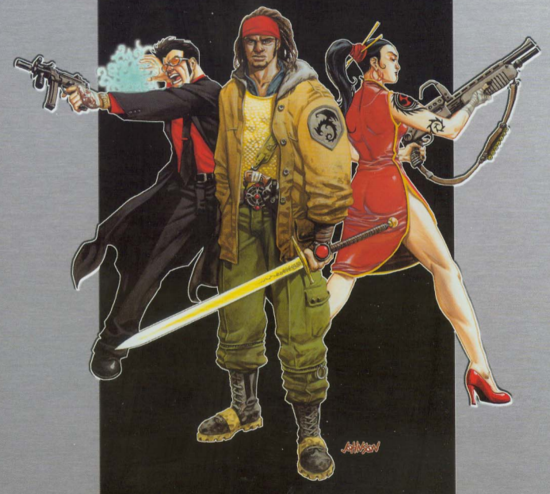
Swords! Guns! Super chiseled Asian babes! Wizards?!?!
The Basics
This is where the book launches into the nuts and bolts explanation of its mechanics. Since it’s based off 3rd Edition, the game uses the familiar d20+modifiers versus target number. Ties are counted as a success (a thing we could never remember when playing). The Basics section then gives general explanations of what characters (heroes) are made up of - ability scores (standard Strength, Constitution, Dexterity, Intelligence, Wisdom, Charisma), your class, level, skills and feats, and a system-specific starting occupation that confers a number of bonuses and represents whatever your character did before becoming a secret shadow government assassin.
A Game Session
This is a run-down of how the game is mechanically played - skill checks, ability checks, combat rounds, and the kinds of actions you can take (attack/move/full-round/free/reactions). Also explained here are action points - these give you the opportunity to add 1d6 to any d20 check, before knowing whether the result is a success or failure. They can also be spent to use certain powers, which will be noted later.
The remainder of the Introduction deals with Playing the Game and its requisite example of actual play, where the intrepid heroes break up a group of ski-mask-wearing people going about their (until combat starts) unrelated business underneath a boardwalk. The intro closes with a character creation summary, and then it’s on to the Real Chapters!
Up next: Characters! Archetypes! Talents! Multiclassing!
Part 2
Original SA post d20 Modern Roleplaying Game Core Rulebook - Part 2
Chapter 1 - CHARACTERS
The Characters chapter opens with a paragraph explicitly tying your character’s performance to their statistics. This sets the tone for how d20 Modern was designed - it’s very much a stats-primary, story-secondary system that rewards system mastery and munchkinning based on your particular Game Master’s proclivities. That said, it also absolutely allows you to develop cinematic heroes that you genuinely enjoy playing, partly for the aforementioned reason.
Character creation follows a decently complex process of choosing ability scores, class, class features, your starting occupation, skills, feats and gear. There are plenty of options (some good, some terrible, naturally), so let’s dig in!
The Abilities
To begin character creation, d20 Modern offers you a choice of methods for generating your character’s ability scores. The first one presented is roll 4d6, keep 3, and assign freely. This is important as your class is tied directly to whatever ability score you choose to make your primary, so you kind of have to know what your character’s going to be good at from the outset. The game gives you an out if you roll truly terribly - if you get nothing higher than a 13, or you have less than a net 0 of your modifiers. Both of these are hard to get, but it’s entirely possible to have a character that doesn’t satisfy the reroll conditions and is still a useless junk-pile.
The other options for ability scores are “planned generation”, or point-buy (using 25 points), and a ‘standard’ score package - 15, 14, 13, 12, 10, and 8. Note that since your character doesn’t receive any racial ability score bonuses, their ability-score-related plus bonuses are slightly lower compared to, say, a level one D&D character (which will probably have an 18 at least).
The six attributes:
Strength governs your melee attacks, damage rolls for melee & thrown weapons, Climb, Jump, and Swim skill checks, and miscellaneous physical checks (like breaking down doors).
Dexterity covers your ranged attack rolls, your Defense and Reflex saving throws, and various skills including Hide, Move Silently, and Drive.
Constitution affects how many hit points you gain when you level up, your Fortitude saving throw, and the Concentration skill.
Intelligence gives you more skill points per level, and is responsible for Search and Knowledge skill checks.
Wisdom is used for the Will saving throw, and the Listen, Spot, and Treat Injury skills.
Charisma applies to your various Bluff, Diplomacy, and Disguise checks, as well as general Charisma checks used to ‘influence others’.
There is a sidebar in the Abilities section that provides some guidelines (just guidelines!) towards using your character’s ability scores to determine how they are roleplayed. These include things like “characters with low Intelligence may mispronounce words” and “a character with high Charisma and low Wisdom may be popular, but he doesn’t know who his real friends are.” Again this promotes the numbers-heavy nature of the game generation, which is sort of quaint to look at nowadays.
The last important thing about ability scores: you gain points in them as you level up (as normal), and they change as you age - your mental stats (Int/Wis/Cha) will increase, while Str/Dex/Con will degrade with character age.
Character Classes
And now we get to the meat of character creation - d20 Modern ’s class system. Instead of assigning you an occupation-based class like other d20 system games, d20 Modern has you choose from one of six Basic Classes. These are, not coincidentally, tied into your ability scores fairly heavily, and the six basic classes are:
Strong: Characters with training in “athletic endeavours”, who are probably good at melee combat.
Fast: Levels in Fast represent “training in agility, hand-eye coordination, and reflexes”, and Fast heroes tend to be good at ranged combat.
Tough: Tough heroes see their levels contribute to “physical fitness, health, and stamina.”
Smart: Smart levels “improve a character’s reasoning and skills.”
Dedicated: Should have perhaps been called Wise, but revolves around “investigative, empathic, healing, and spiritual devotions.”
Charismatic: Levels of Charismatic represent training in being “a leader, a celebrity, a con artist, or a flirt,” and all the social niceties that go along with those.
You are capable of multiclassing, to an extent, freely taking levels of other Basic Classes when you level up, to shore up or extend your character development. There are also Advanced Classes (basically Prestige Classes) that come into play in longer-running/advanced-start games, but are discussed much later in Chapter 6.
Your character’s class(es) contributes to your character in the form of Base Attack Bonus, Base Save Bonus, your available class skills, hit dice, and a number of class talent choices. Base Attack Bonus scales differently for each basic class, and I’ll discuss that in detail when I go over the classes one by one. Save bonus varies similarly, and there’s also a generic Defense bonus that factors into your Defense (or Armour Class). Your class also gives you a Reputation bonus that allows you to call in favours or purchase gear more easily. Characters also receive Action Points, which are a generic resource you can spend for various things, and are tied to your character’s level both in the number you get, and how many you get when you level up.
The other two things you get from your class are choices out of a tiered Talent pool, and bonus feats. d20 Modern treats everyone as human, meaning you get two feats at first level, and also accelerates your feat progression, giving a feat every two levels (2, 4, etc.) you take in a basic class (though these are all off a prescribed per-class list). Meanwhile, you get a talent choice on every odd level, so there's lot of choices to make as you advance.
NEXT: Fast heroes, Moondogs, farmers and MONEY.
Part 3
Original SA post d20 Modern Roleplaying Game Core Rulebook - Part 3
Chapter 1 - CHARACTERS Continued
Like D&D 3 before it, d20 Modern ties its character classes to specific, iconic heroes that are ubiquitous throughout the game’s art. This is actually a really cool thing - you get to see a number of permutations of these iconic heroes, and how they interact with the setting. Wizards has tons of art available to view and I’ll be trying to insert as much as I can into these posts.
So! On to the basic classes.
The Strong Hero
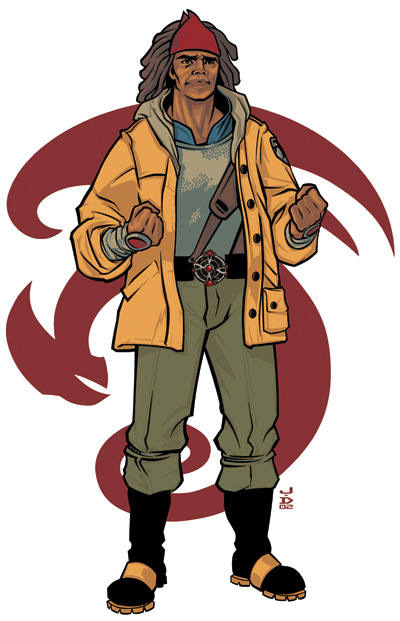
Russell Whitfield, Strong Hero
Strong heroes use their Strength score and training in physical strength and power to contribute to the party. They are boxers, martial artists “some types of soldiers”, athletes (but only some types of athletes), blue-collar workers, and others who “rely on pure brawn”. They tend to favour Constitution and Dexterity as secondary abilities. Strong levels give you a 1d8 hit die, and their class skill list is pretty narrow: Climb, Craft (Structural), Handle Animal, Jump, Repair, and Swim, plus various language skills. The Strong hero is the guy who clubs Batman on the back of the head with a giant pipe wrench.
Strong heroes have the best Base Attack Bonus progression: +1 per level, starting at level 1. Their Fort save and Defense bonuses start at +1 and scale every even level (maxing out at +5 at level 10), and their Reflex and Will save bonuses cap at +3. They have the worst Reputation bonus scaling of any class, starting at +0, and only ending at +2 at level 10. They get 3+Int skill points per level, which is the worst you can get. They get Simple Weapon Proficiency for free, but so does practically every other class.
The talent trees for Strong heroes are Extreme Effort, Ignore Hardness, and Melee Smash, each with three levels. Extreme Effort gives you a +2/+4/+6 bonus to any Strength or Strength-based skill check, but requires a full-round action (meaning you can’t get the bonus on, say, a quick Jump). Ignore Hardness lets you do just that - ignore 1/2/3 points of an object’s hardness when making a melee attack. Melee Smash gives +1/+2/+3 damage on all melee attacks. This is the first obvious better/worse dichotomy - unless you really want to cut through armour plating with your Hanzo steel, you’re better off just taking Melee Smash.
The Strong hero’s bonus feats are things like Archaic Weapons Proficiency, Cleave, Combat Martial Arts, and Weapon Focus...and Animal Affinity.
The Fast Hero

Yoriko Obato, Fast Hero
Fast heroes prioritize their Dexterity score and are known for their agility, hand-eye coordination, and quick reflexes. They are athletes who favour speed and grace, stunt people, pilots, and gun-wielding agents skilled at sleight of hand. The book suggests also placing good scores in Charisma, Intelligence, and Wisdom to boost your character’s effectiveness. Like the Strong hero, they use 1d8 for hit dice, and have a skill list that cover things like Balance, Pilot, Drive, Ride, Move Silently and Tumble. They luckily get 5+Int for skill points, which is average. The Fast hero is the one who shoots Batman with a poison dart from her hiding place in the shadows.
The Fast class BAB progression is middle of the road, capping out at +7/+2 at level 10, and their save progression mirrors Strong heroes, though Reflex gets the best bonus. They get a huge defense bonus, however, starting at +3 and ending at +8. This is somewhat important later! They also have a really crummy reputation bonus - nobody likes the stunt driver, apparently. And, like Strong heroes, they start with Simple Weapons Proficiency.
Fast heroes have only two talent trees: Evasion, and Increased Speed. Evasion mirrors the various rogue-type class features from D&D - you can make saves to avoid area attacks, retain your Dex bonus when ambushed, become immune to flanking, or spend an action point to make an attack of opportunity against an enemy that has just been hit by an ally. The Evasion tree also contains Defensive Roll, a talent that allows the Fast hero, when they would otherwise be reduced to 0 HP, to spend an action point, make a Reflex save (where the DC is the damage dealt), and potentially avoid death. Compare and contrast to Strong talents! Increased Speed is a simple 5/10/15 foot move speed increase - which is pretty powerful as well, considering.
Bonus feats for Fast heroes are things like Combat Throw, Double Tap, Personal Firearm Proficiency, Stealthy, and Weapon Finesse. Nothing too weird here, unfortunately.
The Tough Hero
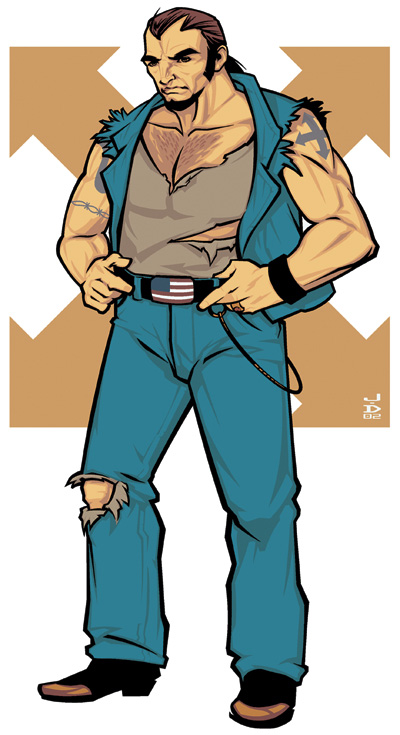
MOONDOG GREENBERG, TOUGH HERO
The Tough hero uses Constitution as its foundation, deliberately positioning itself as a class to be able to take hits and perform feats of endurance. They are bodyguards, wrestlers, enforcers, and stunt people. Tough heroes value Strength, Dexterity, and Wisdom as secondary abilities, since they have a weird mix of class skills - Climb, Concentration, Drive, Ride, Spot, and Survival, amongst others, and their class skills span four ability bonuses. With a 1d10 hit die they stand to gain the most HP on level ups (boosted again by their high Constitution), but they get 3+Int skill points, so you have to be pretty picky as to what you declare your character to be good at. Tough heroes are the super-bulky henchmen that Batman tries to punch out but ends up breaking his hand in the process.
Their BAB progression mirrors Fast heroes, and their save bonuses and Defense bonus progression are the same as Strong heroes, so there’s some synergy there for multi-classing. Tough heroes have three talent trees - Damage Reduction, Energy Resistance, and Unbreakable. You can’t pick from Damage Reduction at level 1, but it’s listed first (due to alphabetization), which is sort of obnoxious.
Energy Resistance has five talents that do the same thing: grant your character resistance to a specific energy type (acid, cold, fire, electricity, or sonic damage) equal to your Constitution modifier. Unbreakable’s talents are Remain Conscious (gives you a single action per round when dying), be Robust (gain additional HP equal to your Tough level), perform a Second Wind - which is the design precursor to 4E’s non-cleric healing - or have Stamina that allows you to heal twice as fast as normal when resting. Once you’ve grabbed one of the talents from Energy Resistance or Unbreakable, you can cross over into Damage Resistance, which gives 1/2/3 DR as you spend more talents there.
The Tough hero’s bonus feats include Alertness, Confident, Improved Brawl, Knockout Punch, Streetfighting, and Vehicle Expert.
A Note on the Art
With this post I’ve been able to include some of the superb art that d20 Modern featured, and I’d like to call out how progressive and generally-inclusive the art direction and writing is overall for the game. The writers take pains to use things like “stunt person” instead of stuntman, and there are lots of “a character” instead of he/she/thems. The art, as well, tends to do a better job of depicting persons of colour, and women, than most RPGs (especially at the time). While there are lots of examples of this not being the case (Yoriko’s picture above, for instance, and there’s one of a gnoll pimp later), the positive examples are probably as frequent, so re-reading it now, it’s kind of nice to see that an effort was being made.
Next: Smart people, dedicated people, and
Part 4
Original SA post d20 Modern Roleplaying Game Core Rulebook - Part 4
Chapter 1 - CHARACTERS Continued
Last update was the physical-stat basic classes. This time around, I’m looking at the three others: Smart, Dedicated, and Charismatic heroes.
The Smart Hero
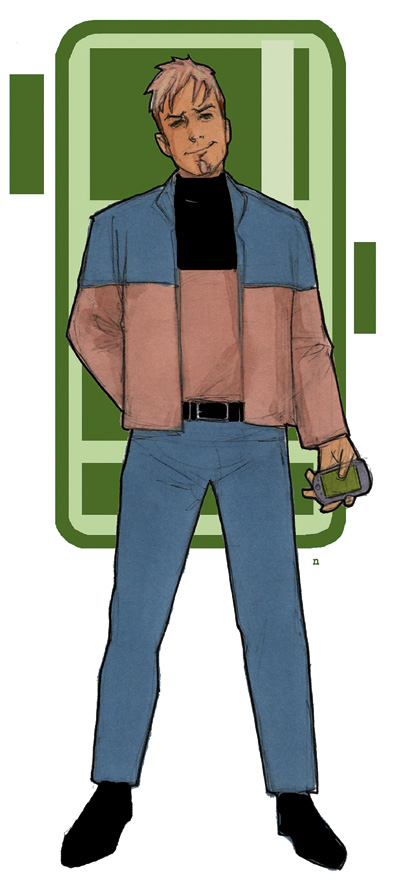
Brandon Cross, Smart Hero
Smart heroes are scientists, researchers, tacticians, and white-collar professionals. They possess heightened reasoning skills and the ability to think their way through complex situations. For secondary abilities, they trend towards Dexterity (for guns) and the other mental abilities to bolster their skill set. They get the bad hit die - 1d6 - but make up for it with the most skill points of any class (9+Int, so probably 13+ per level), and have a massive skill list to spend them on - Computer Use, a bunch of Craft skills, Demolitions, fourteen individual Knowledge skills, Repair, Search, and more. The Smart hero is the lab coat that gets tossed off-screen by the explosion when Batman blasts his way into the villain’s underground techno-lair.
Along with their crummy hit die, Smart heroes have bad BAB progression - starting at +0, getting +1 every even level and capping at +5. Their save bonus favours Will, and they have a similarly bad Defense bonus progression (even worse than Strong/Tough heroes). So they’re weak and can’t fight very well, with the trade-off being a huge pile of skills, and some questionably-excellent talents from their trees - Research and Strategy.
You’re required to take at least one Research talent before you can expand into Strategy. Research options are Savant, which allows you to add your Smart hero level to a chosen skill’s checks (can be picked multiple times for several skills), or Linguist, which allows you to make an Int+Smart Level check to be able to basically understand any language you come across. The DCs aren’t super-arduous (15 for a language in a group you already are familiar with, 20 for an unfamiliar group, 25 for weird/ancient languages), and if you’re attempting to translate writing you can make a Decipher Script+Smart check, which is great because you’ll have loads of skill points. It’s ambiguously written, too, so you may be able to double-dip on your Int bonus (potentially giving you a +9 at level 1). Kind of neat depending on your campaign, but requires you to dump 3 skill points into learning a few languages.
The Strategy tree is the actual combat-useful talent set for Smart heroes. The first option is Exploit Weakness - pick an enemy, spend a move action to make an Int check versus DC 15, and if you pass, you can use Int instead of Str or Dex for your combat rolls (but only against that one enemy). The second talent is Plan, which lets you spend a minute prepping your team before a dramatic situation, and you make an Int check which confers up to a +3 bonus to all skill & attack rolls for the first 3 rounds of the dramatic situation. Finally, there’s Trick, which has you spend a full-round action to make an Int check to potentially daze an enemy for one round. I say potentially because the trick can be resisted with a successful Reflex save, at which point you’ve blown a full-round action for nothing, and can’t try again on that enemy.
So the talents are pretty situational/one-time use combat tricks that might help in a pinch but are nowhere near as good as steady damage, avoiding death, or running super fast. At least your bonus feats are weird! You can take things like Builder, Combat Expertise, Improved Disarm, Meticulous, or Vehicle Expert.
The Dedicated Hero
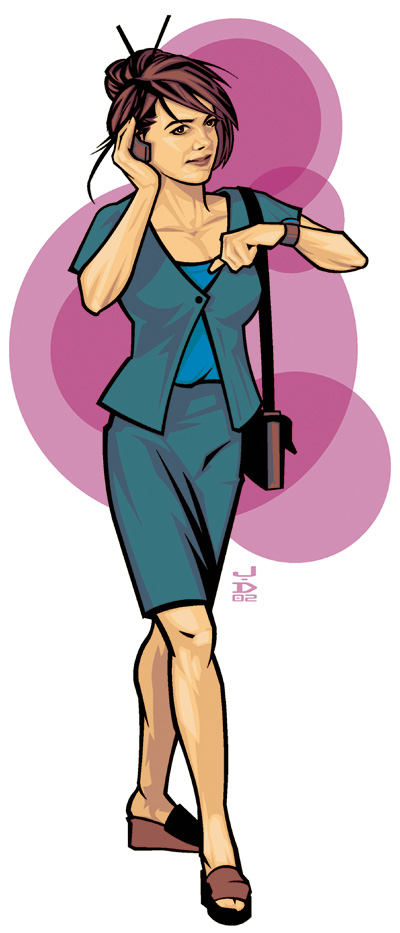
Lily Parrish, Dedicated Hero
Next up: Dedicated heroes. These are heroes that have chosen to prioritize their Wisdom scores, focusing on common sense, perception, and intuition. They might be devoted to a cause, ideal, or faith, but mostly they possess a faith in their own abilities. They are health care workers, investigators, activists, and clergy. They favour Intelligence and at least one physical ability for secondary focuses. With a 1d6 hit die and mediocre 5+Int skill points, they fall behind Smart heroes in terms of raw knowledge (naturally) but get access to a number of unique and important skills: Gamble, Sense Motive, Spot, Survival, and Treat Injury, to name a few. The Dedicated hero is the preacher in the church that Batman crashes through the stained-glass window of, in pursuit of some weird vampire.
Dedicated heroes have moderate BAB progression, and actually get two ‘good’ save bonuses (Fort & Will) which is a first for a basic class. They also feature a midline Defense bonus progression, and good Reputation bonus as well. So they’re less fragile and more combat-ready than Smart heroes, at least! They have three talent trees: Empathic, Healing Knack, and Skill Emphasis, all of which are open to them at level 1.
Empathic’s talents are tiered: first is Empathy, which gives you a bonus to interaction skills (Bluff, Intimidate, Sense Motive, etc.) provided you can spend a minute observing the target. Once you’ve got that, you can access Improved Aid Another (gives a +1 bonus to aiding, stacks if you take the talent repeatedly), or Intuition, where you can make a Will saving throw versus DC 15 to “get a hunch” from the GM as to whether a specific situation is all right, or going sour. The Healing Talent tree is tiered into Healing Knack (+2 to Treat Injury), Healing Touch 1 which gives +2 hit points when performing first aid/surgery, and Healing Touch 2, which gives another +2 hit points. Finally, the Insightful tree has Skill Emphasis, which gives you a +3 to checks with a chosen skill, Aware, which adds your base Will bonus to Listen or Spot checks to avoid surprise, Faith, which lets you spend an action point to add your Wis modifier to most D20 rolls, and finally Cool Under Pressure, which lets you select several skills and be able to take 10 even when under duress and using them.
So there’s some decent stuff there, and since probably one member of your group is de facto going to be playing a Dedicated hero, that’s a bonus. Thankfully you get some cool bonus feats too: Advanced Firearms Proficiency, Archaic Weapons Proficiency, Blind-Fight, Far Shot, Surgery, Medical Expert, and more.
The Charismatic Hero
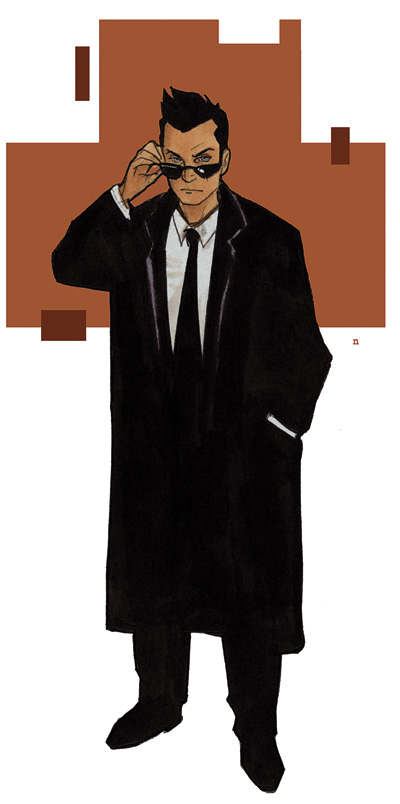
Troy Bellarosa, Charismatic Hero
This brings us to the final basic class: the Charismatic hero. Naturally, they favour a high Charisma ability, and not much else - the book suggests at least one physical stat, but that’s it. Charismatic heroes are persuasive leaders, attractive celebrities, flirts, fast-talkers, spies, and suave gamblers (though they don’t get Gamble as a class skill!). They have a 1d6 hit die, but 7+Int skill points that they can spend on things like Bluff, Gather Information, Disguise, and Perform. Charismatic heroes are the smug Gotham socialites at the party that Batman crashes into while chasing a weird vampire.
Charismatic heroes have ‘bad’ BAB progression, but get ‘good’ save progression in both Fort and Reflex. They also suffer from bad defense bonus progression, though as befits a schmoozing glad-hander, their Reputation bonus is the best of the basic classes. For Charismatic talents, there are three trees: Charm, Fast-Talk, and Leadership.
The Charm tree leads off with Charm (of course!), which gives you a bonus to Charisma-based skill checks against a chosen gender (and you can’t choose twice). It’s followed by Favor, which lets you spend action points to request minor aid from anyone you meet, provided you can make a skill check (DC 10 to 30 depending on the difficulty and danger of the task). The GM has heavy control over what favours should or should not be allowed, and “getting a favour shouldn’t replace good roleplaying or the use of other skills”, so depending on how much of a jerk you’re dealing with, this is a bunk choice, or an OK one. Last in the Charm tree is Captivate - this talent allows the Charismatic hero to make a Charisma check to attack a target (which can resist) and if successful, the target fixates on the Charismatic hero, allowing their allies to act around the enemy unnoticed.
Fast-Talk’s tree starts with Fast Talk, a simple bonus to Bluff, Diplomacy, and Gamble when attempting to lie or cheat. This gives access to Dazzle - a Charisma-based attack that causes affected targets to suffer a penalty to d20 rolls, and can be taken multiple times to increase the penalty. After that is Taunt, which is a strictly-better version of the Smart hero’s Trick (can be used multiple times, only takes an attack action, can be used if it fails) that dazes an affected opponent. The final Charismatic talent set is Leadership, which begins with Coordinate - spend a full-round action to give a bonus to allies, then Inspiration and Greater Inspiration, which allow your allies to spend full-round actions watching you to gain up to a +3 bonus to attack, damage, and saving throws. Bonus feats for Charismatic heroes include Creative, Dodge, Frightful Presence, Low Profile, and Windfall.
So yeah! That’s that for the basic classes. Once you’ve decided on what kind of hero you want to be, you’re tasked with choosing an occupation that explains their background a little bit.
STARTING OCCUPATIONS
Every character has a starting occupation. This is sort of a background to your character that confers several bonuses at character creation. Each occupation has a pre-requisite that is generally a minimum character age (though there’s one that requires minimum ability scores). They allow you to select a few bonus class skills (or existing class skills to receive a +1 bonus), sometimes bonus feats, and a Wealth bonus increase. There are around twenty occupations, so I’m not going to run through them here - just a couple of examples
Adventurer represents your character being a daredevil, big game hunter, or field scientist. It requires age 15+, gives access to two class skills like Bluff, Demolitions, Jump, Pilot, Swim, and Treat Injury (it’s actually a HUGE and variable list), comes with a bonus weapon proficiency feat and a +1 Wealth bonus increase.
Dilettantes are characters that have gotten their wealth from trust funds, and have no “real” job, instead devoting their time to philanthropy, a cause worth fighting for, or simply living a fun, carefree existence. They receive only one bonus class skill from a very short list (Gamble, Intimidate, Knowledge, Ride, or Speak Language), but get +1 Reputation and a whopping +6 Wealth bonus increase.
Technicians are scientists and engineers of all stripes, require age 23+, and get three class skills (generally practical like Computer Use, Craft, Repair, or Research), and a +3 Wealth bonus increase.
VITAL STATISTICS
As evident from the previous section, your character’s age matters in d20 Modern. As you age, your stats change as well: when you hit age 40, you take -1 to Str, Dex, and Con, while gaining +1 to Int, Wis, and Cha. By the time you hit 60, you end up taking another -1/+1, and at 80 a third ability shift. There are also tables in this section for random height and weight, and all that jazz.
ALLEGIANCES
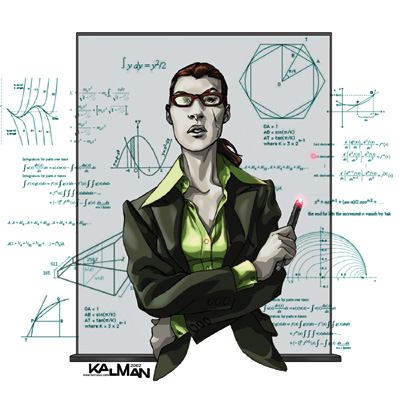
She has an allegiance to math, and conspicuous scars.
As part of developing your character, d20 Modern provides an optional allegiances system that serve primarily as a roleplaying tool. You can declare your character to be aligned with a person or group, or a larger organization, nation, or belief system, or even a moral or ethical philosophy, and when given the opportunity to deal with someone of the same allegiance, you receive a +2 bonus on Charisma-based skill checks - provided you can ascertain that they *are* of the same allegiance as you (apparently you can’t know this just by looking at them).
REPUTATION
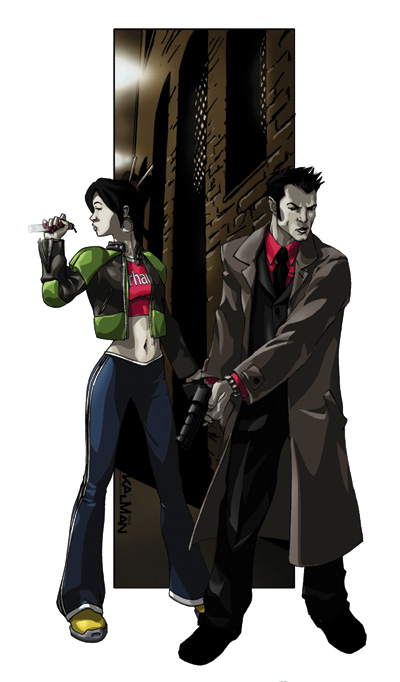
These guys have a reputation for being mediocrely-drawn!
Every d20 Modern character has a reputation that they gain over their heroic career, which takes the form mechanically of their Reputation bonus. This comes into play when your character encounters NPCs in the game - and can be a good or bad thing, depending. Characters with a +4 or better Reputation bonus can be considered famous - or infamous - in their social circles or professions, depending on the NPC they’re interacting with.
There’s a convoluted Reputation check procedure that takes into account the PC’s bonus, their relationship to the NPCs, fame, and how knowledgeable the NPC is in their own circles. “Success” at this check indicates you are recognized by the NPC, and depending on whether you’re in their good books, you receive a +4/-4 modifier to Charisma skill checks with them.
WEALTH
Since having characters tote around bags of gold pieces and star diopsides would ruin the verisimilitude, d20 Modern makes use of a Wealth system to represent how affluent your character is, and how much purchasing power they possess. Every character has a Wealth bonus generated at character creation (2d4), that can be modified by their starting occupation, and the Windfall feat. Wealth decreases as you purchase expensive items, and increases as you gain rewards from your actions.
The Wealth bonus is an abstract concept. There is no actual cutoff in terms of monetary value between wealth bonus levels, but they can be roughly correlated to +0 representing being completely impoverished, +5 to +10 indicating middle-class, and +31 or greater meaning you’re Very Rich. The main book covers purchasing several chapters later, but I’m going to skip ahead and throw the purchasing rules from Chapter 4 here anyway, since people are jonesing for them. So, without further ado:
PURCHASING EQUIPMENT
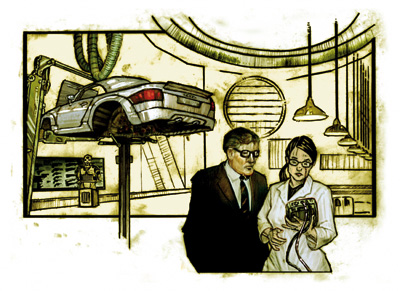
"Yes, this souped-up spy car will set you back around 3 Wealth points.
So as noted before, your starting Wealth bonus is 0+2d4+Occupation+(Windfall)+1 for having ranks in a Profession skill. All objects, from disposable cameras to heavy machine guns, have a purchase DC that corresponds to how pricey they are (4 and 22, in this case). To purchase an item, you need to make a Wealth check using your bonus and if you succeed, you buy the object. You also have to spend a number of hours equal to the purchase DC shopping for the item. You can take 10 or take 20 to represent spending a lot of time shopping for an object. If you fail a wealth check, you can try again, but you have to spend the time shopping. Furthermore, if you fail a Wealth check during character creation, you have to spend some in-game time trying to buy the thing you were looking for (no retries!)
Assuming you do manage to buy something, your Wealth bonus will (generally) be reduced, depending on a few things. If you buy an item with DC15 or greater, you lose 1 Wealth automatically. If that item is above your current Wealth bonus, you lose an additional 1 to 2d6 points, depending on just how much of a split between your Wealth and the DC are (1-10 = 1 point, 11 - 15 = 1d6, 16+ = 2d6). So if you have a Wealth bonus of +9, and you buy a handgun with a DC of 16, you go down to +7. Functionally, what this means is you are free to buy as much stuff under your Wealth as you want, and then start making big-money rolls, and if you have a Wealth of +14 or higher, you can basically afford mundane gear endlessly.
So your Wealth decays as you purchase more and more expensive gear, which is fine. Regaining Wealth happens in one of two ways: first, when you level up, you make a Profession skill check (or a Wisdom check if untrained) and, if you beat your current Wealth, it goes up by +1 for each 5 points by which you beat the DC. The second way is wealth awards - finding a big treasure, getting a cash reward, et cetera. The means of calculating this are tied to the CR/encounter level system, which pulls a whole host of other issues along with it into the game. All told, Wealth is actually a pretty cool system, but exploitable if you know how to juke your math, and also a bit too nebulous in terms of advancing it along with your narrative. It also fails to take into account looting of equipment, which can fundamentally sidestep the system.
Next update: Skills! Maybe also feats?!?!?
Part 5
Original SA post
Hey y'all, I went on vacation for a week, but here's another d20 Modern thing! Also re: discussion several pages ago, feel free to archive this tripe wherever you'd like.
d20 Modern Roleplaying Game Core Rulebook - Part 5

Chapter 1 - CHARACTERS Finale
Last time I polished off characters and went over the Wealth system. This update it’s about experience, leveling, multiclassing, and skills.
Gaining Experience and Levels

Grindy.
Your character’s growth is metered by their XP gained. Experience points are accrued through overcoming challenges (combat or otherwise) and when you’ve accumulated a sufficient amount, you gain a level. Pretty straightforward! If you somehow manage to gain enough XP to pull off two levels at once, well, tough, because you lose any extra XP and are set 1 short of your second level-up.
When you do ascend to that next lofty level, a bunch of numbers go up. You can choose to gain a level in your current class, or multiclass into a new one. Once you’ve decided what class to take, you inherit whatever bonuses they have at that current level for base attack, defenses, and saves. If you’re achieving a multiple-of-4 level, you also raise one of your ability scores by 1, and if it’s a multiple-of-3 level, you get a feat too (which can be any feat, not just a class bonus list one). You gain skill points, and accrue a bunch more action points, and lastly, make a Profession check to attempt to increase your Wealth bonus.
Probably the important thing here game-wise is that you only gain more action points upon leveling up. This means that if you have class features or feats that require you to spend an action point to perform them, that you have to meter them out specifically between your level-ups (which can be completely impossible to pace), but you at least get a healthy quantity per level.
MULTICLASS CHARACTERS
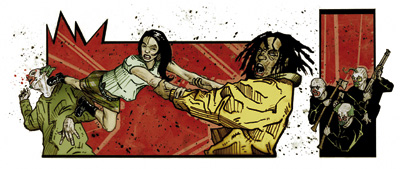
Multiple single-class characters. Hey, wait a minute!
So you don’t necessarily feel like your character needs to be the pinnacle of cat burglary, or that your research scientist has hit the gym sufficiently to merit some Strong-ness.
d20 Modern
allows and potentially encourages multi-classing, allowing your character to dabble in a couple of basic classes with the hope of either shoring up their weaknesses, or creating a combo-build monster-person.
Chapter 2 - SKILLS
So along with a number of mechanical stats related to how good you are at punching and shooting things, or how easily you can confuse a bad guy, characters in
d20 Modern
receive a pile of skill points to allocate towards a (frankly ridiculous) array of skill options that help flesh out your non-combat capabilities. As mentioned previously, class skills are limited based on what hero levels you have as well as what’s granted by your chosen background.
Skill checks are pretty easy to make: 1d20 + your skill rank + ability modifier +/- miscellaneous modifiers. You compare your result to a Difficulty Class, and if you meet or beat the DC, you succeed at your skill check. Skill checks can also be opposed (Move Silently is opposed by a Listen check, for example). As you advance in level, you gain skill ranks (again determined by your class), but DCs scale accordingly, so it’s sort of a zero-sum game.
DCs range from easy (DC 5, climbing a knotted rope), to nearly impossible (DC 40, “track a trained commando through the forests of Brazil on a moonless night after 12 days of rainfall” using Survival). There are also opposed checks, where your opponent makes a skill check using, say, Spot to counter your Disguise check, or opposed Drive checks to represent a car chase. Assuming you don’t hit your DC, you can generally try again, assuming you’re doing something for which there is no immediate negative consequence. Failure by 5 or more means you trigger said negative consequence (tripping an alarm or fucking up a lock you’re disabling, for instance), though. There are the standard take 10/take 20 options, too, assuming no extraordinary consequence for failure.
The rest of the Skills preamble involves bonuses and penalties for things like adverse conditions, superior trade toolkits, or other circumstantial benefits or hindrances.
d20 Modern
also includes a skill synergy system: having a number of ranks in certain skills gives you a bonus to others, which is kind of cool!. Next there’s a full-page table (!) summarizing every one of the skills in the game. For reference, there are forty-one
main
skills, and three of those (Craft, Knowledge, and Perform) have 29 unique sub-areas, bringing the total to 70 total entries in the big list. For sake of (moderate) brevity I’m not going into too much detail on any of them. However, here’s some quick fun notes on certain skills.
Climb (Str)
includes specific bonuses for climbing inside air vents!
Computer Use (Int)
covers almost two full pages on how to roll dice and pretend you’re hacking.
Craft (chemical) (Int)
lets you make an infinite number of small IED-type explosives (1d6/5’ radius) for free at a rate of 1 per minute (or 1 per round if you’re feeling lucky).
Craft (everything else) (Int)
has its most basic DC set at 15 - it’s easier and cheaper to make a bomb than its detonator, or a bookshelf.
Diplomacy (Cha)
has extensive rules for bribery.
Forgery (Int)
has the GM make checks for you so you don’t know how good a job you did until it’s too late!
Gamble (Wis)
allows you to sidestep normal Wealth progression and become a HIGH ROLLER.
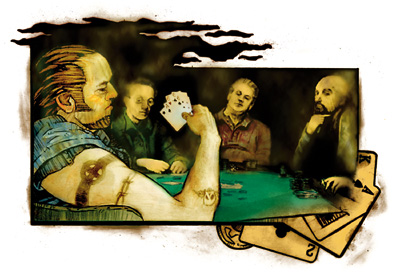
Moondog Greenberg: weird ink, weirder arms.
Handle Animal (Cha)
lets you teach snakes and sharks verbal commands like ‘Attack!’ or ‘Fetch!’ (Moondog, stop trying to make fetch happen!).
Hide (Dex)
requires
Move Silently (Dex)
to make stealth happen - skill taxes all around!
Knowledge (Int)
has fourteen subcategories including arcane lore, current events, tactics, and theology.
Survival (Wis)
only lets you track people/animals if you also spend a feat to be able to do so.
Treat Injury (Wis)
allows you to heal people, but that means 1d4 hit points to someone
once a day
without having to perform extensive surgery (which is a pretty involved process). More on healing later!
I am going to cut it a bit short here, and tackle Feats as a separate post. So those are coming up next!
Part 6
Original SA post d20 Modern Roleplaying Game Core Rulebook - Part 6
Chapter 3 - FEATS
And now we come to the super crunchy part of character creation - feats! These are options you can select for your character when gaining certain levels that allow you to specialize and improve some aspect of your character that isn’t governed by skill points or simple class progression. Feats cover everything from simple mechanical boosts (+1 to attack!), to being able to use a heavy machine gun, to being able to terrify everyone within ten feet. d20 Modern hands feats out like candy - your typical level 6 mono-class character will have four standard feats, plus three bonus feats, potentially gaining one more from occupation. Furthermore, due to a slight decrease in wizard supremacy, feats are actually somewhat useful for all characters, and the ones that give you exciting combat tricks aren’t dumb, underpowered gimmicks (since everyone is dumb and underpowered
 ).
).
There are around ninety-five feats included in the core rulebook, but I’m going to attempt to explain most of them in at least some degree of detail, because they’re probably the most important part of character creation and advancement. I’ll try and group them into families where possible, too.
Skill Feats: Acrobatic, Alertness, Animal Affinity, Athletic, Attentive, Cautious, Confident, Deceptive, Educated, Focused, Gearhead, Guide, Medical Expert, Meticulous, Nimble, Stealthy, Studious, and Trustworthy. All of these do the same thing: grant +2 to a couple of related skills.
Martial Arts Feats: Combat Martial Arts turns your fists into weapons capable of dealing lethal damage, and is a prerequisit for Improved and Advanced Martial Arts, which expand your crit range and give you x3 criticals respectively. There’s also the Defensive Martial Arts branch that features various judo-type moves (Combat Throw and Unbalance Opponent) and basically boost your ability to grapple.
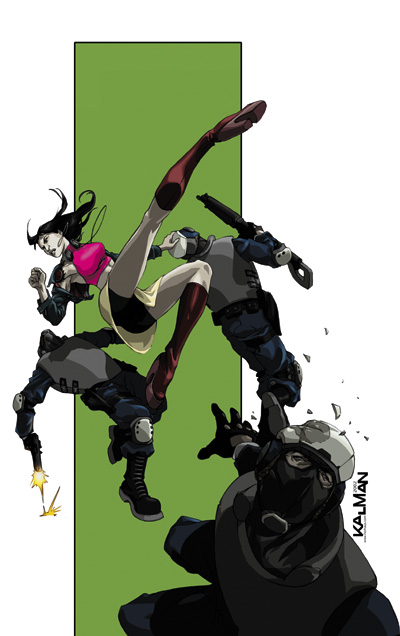
Combat Martial Arts + Combat Skort = TIGER KICK
These are in contrast to the Brawl Feats: Brawl increases your unarmed nonlethal damage, Improved Brawl beefs it up further, Knockout Punch makes your nonlethal unarmed attacks into automatic critical hits, and Improved Knockout Punch makes those crits deal triple damage. Note that Knockout Punches only work against flat-footed opponents, and only on your first attack against them, so the feat might as well be called Sucker Punch. There’s also Streetfighting and Improved Feint which let you wrassle a little better.
Dodge Feats: Dodge makes you more difficult to hit - +1 to Defense versus a chosen enemy, but keys into a few more exciting feats - Agile Riposte, which lets you make an attack of opportunity against a target that misses you in melee combat, Mobility, which is a big bonus to Defense versus AoO, and Spring Attack, which lets you move before and after making a melee attack.
Proficiency Feats: Archaic Weapons Proficiency makes you equally adept with bow, sword, axe, and guisarme, while Armour Proficiency (light/medium/heavy) let you stomp around in a SWAT suit while poking people with your sword cane. Meanwhile, Personal Firearms Proficiency is required for gun-shooting (-4 to attack without it), and keys into Advanced Firearms Proficency, Burst Fire, and Strafe, which improve your ability to hose down an area...with bullets. Exotic Melee Weapon Proficiency and Exotic Firearms Proficiency let you pick a single melee weapon, or class of ranged weapons, and use them with no penalty.
Shooting Feats: Point Blank Shot confers a +1 to attack and damage on ranged attacks made within 30 feet (clearly to combat fighter supremacy), and also leads to Double Tap - letting you take a -2 to attack for an additional damage die (compare to Power Attack), Precise Shot, which allows you to shoot into melee, Shot on the Run, the ranged version of Spring Attack, and Skip Shot, which allows you to ignore cover for a -2 attack and -1 damage die penalty. There’s also Far Shot to get 1.5x the range on your gun, and Dead Aim to get extra bonuses when you spend a full round aiming.
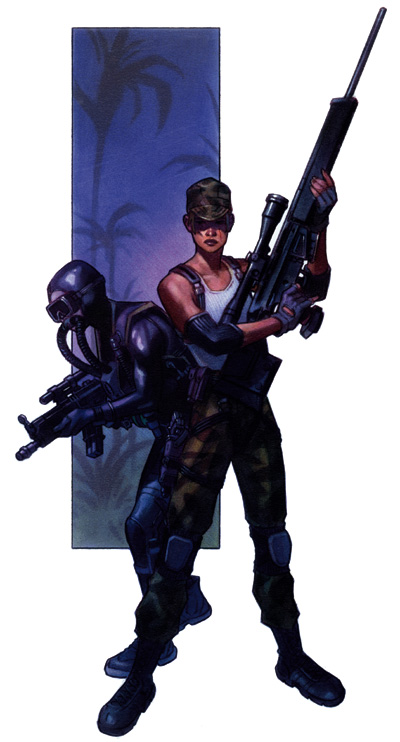
Some Metal Gear bosses show up.
Melee Feats: Starting with Power Attack which lets you take up to -5 to attack to get the same bonus to damage, then there’s Cleave (make an additional melee attack when you kill a melee target once per round) and Great Cleave (which removes the limit), Improved Bull Rush to shove your enemies, and Sunder to allow you to smash your opponent’s weapon with your sword.
Combat Expertise lets you take up to a -5 to attack for a corresponding Defense bonus, and requires Int 13 - use your wiles to avoid getting shot! It also trees into Improved Disarm and Improved Trip which are straightforward, and Whirlwind Attack, which requires 4 prerequisite feats, Dex and Int 13, and lets you make one melee attack against ALL ENEMIES WITHIN 5 FEET. So you can go totally wild as a kung-fu smarty-guy - assuming everyone rushes you.
Two-Weapon Fighting , its Improved, and Advanced versions allow you to make a number of two-weapon attacks (1, 2, and 3 respectively) with less penalty than normal. It applies to both melee and ranged weapons - John Woo fans are fully allowed in d20 Modern.
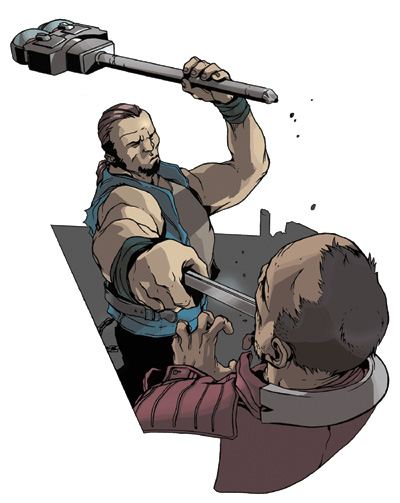
Tough Guy Feats: Things like Improved Damage Threshold (increases your massive damage threshold, more on this later), Iron Will and Lightning Reflexes (+2 Will/Reflex saves), and Toughness let you be a huge swole-ass Moondog.
Vehicle Feats: so you wanna go fast? Check out Vehicle Expert for a minor bonus to your Drive and Pilot checks, and Vehicle Dodge to let you swerve out of the way of a rocket launcher more easily. Also Force Stop lets you run people off the road more easily, and Drive-By Attack lets you live out your GTA-est game fantasy. There’s also Aircraft Operation for flying helicopters and all manner of other wing’d abominations.
Miscellaneous Junk: There are a few feats that don’t really fit into a category. Shit like Renown (+3 reputation) and Windfall (+3 Wealth bonus and a bonus to Profession checks), the all-important Surgery for healing beyond minor cuts and scratches, Quick Draw and Quick Reload, and Run, which lets you run 25% faster than another person. There’s also Frightful Presence, which lets you intimidate anyone within 10 feet - if successful they take a -2 penalty to attack rolls, saves, and skill checks. Weirdly, Frightful Presence gets a bonus if you have the Renown skill as you can apparently scare people with your celebrity.
So yeah: look at all those feats! Holy shit! And the vast majority of them combat-related. This is a game that knows what it’s meant to be: big cinematic fightin’, and the occasional skill usage.
Next time: GUNS. LOTS OF GUNS.
Part 7
Original SA post
HEY FRIENDS I'M BACK WRITING ABOUT THIS GAME
d20 Modern Roleplaying Game Core Rulebook - Part 7

Chapter 4 - EQUIPMENT
Along with the super-crunchy feat selection process,
d20 Modern
contains a veritable mail-order catalog full of guns, vehicles, and other equipment to use for turning mild-mannered research scientists into combat-hardened death machine research scientists with guns.
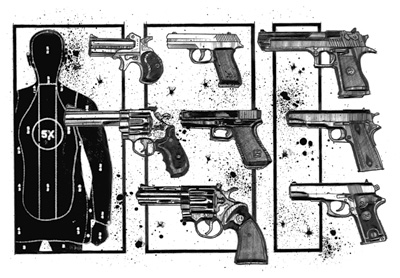
Yes, guns.
As mentioned back in
Part 3
, purchasing equipment is accomplished not by a discrete spending of actual currency, but by leveraging your character’s Wealth bonus to buy items within and beyond your means. Beyond the Wealth check mechanic, most of the fun items have a secondary restriction on their purchase based on the nature of the item.
d20 Modern
categorizes these items under a license system with four categories - licensed, restricted, military, and illegal. You can ‘purchase’ a license legitimately - though a basic License starts at DC 10, and an Illegal one is DC 25 - and doing so requires you to spend 1 - 4 days securing the paperwork. You can speed this up to 1d6 hours with a Knowledge (business) check, however.
If you don’t/can’t handle dealing with Big Government, your character can always head to the black market to get their hands on some extremely caustic chemicals to use for repainting your deck. Accessing the black market requires the use of Knowledge (streetwise), and generally just means you are going to take a heavier hit on your Wealth check than you would otherwise. You can also attempt to expedite the time it takes to acquire your fully-automatic deer-hunting heavy machine gun by further bumping up the Wealth DC.
So what if you’re part of a semi-invisible para-governmental organization dedicated to tracking and eliminating extraterrestrial influence? Well,
d20 Modern
has you covered there, too. There are rules for requisitioning equipment based on a number of modifying factors - its necessity to the assignment at hand, its general rarity and legality, whether you’re personally proficient with the item in question, and whether you filled the attack helicopter up with gas before you returned it on your last mission.
Past the requisition rules are the rules for selling items, generally addressed at players who intend to Monty Haul the sidearms and gold teeth from every dead mook in the Triad bio-experimentation facility back to Department 7 with them. The short of it is basically “you can try selling a pile of questionably-sourced handguns on the black market, but it’ll be a problem” as well as “unless you’re selling a car or Faberge egg, don’t expect much of a bump to your Wealth”.
Lastly, prior to actually getting into the weapons section, there’s a pile of rules for concealing items on your person. Basically, most objects and weapons are assigned a size (from Fine to Huge or larger) and carries a corresponding bonus (or penalty) to your Sleight of Hand (there’s that skill granularity again!) check. Apart from the size of the thing, you can further modify your Sleight of Hand check by doing things like wearing bulky clothing or a concealed carry holster. Also to note: when you conceal a weapon, if you want to be able to draw it normally (as a quick action) it is an automatic -2 penalty to your Sleight of Hand check, or a -4 if you want to be able to use your Quick Draw feat to whip back a trenchcoat, revealing a pair of MP5Ks.
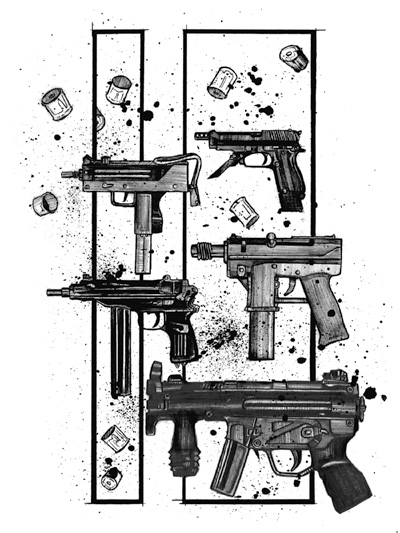
Yes! Guns!
WEAPONS
Since this is a crunchy roleplaying game for the D&D crowd, the equipment section naturally leads off with weapons. The game breaks them down into three categories: ranged weapons, explosives and splash weapons, and melee weapons, and these are further subcategorized (ranged is split into handguns, longarms, and “other” ranged weapons, for instance). Each individual weapon has its own statline that encompasses a number of factors. For ranged weapons, this consists of:
- damage & critical range
- damage type (though all firearms are ‘ballistic’-type damage)
- range increment (you take penalties for attacking at distance multiples of this value)
- rate(s) of fire (single shot/semi-automatic/automatic)
- magazine (which affects how easy the weapon is to reload)
- size, weight, purchase DC, and restriction (generally licensed or restricted)
The obvious design goal of having all of these variables is to include weapons with variation, where each one feels unique and has its own trade-offs compared to others in its category. When I set out to do this dissection I remembered this as being a failing of the game system, but on a re-read it’s not so bad (for the core book, at least, the supplements are their own story). There are still some clearly same-y firearms, however: the Colt Double Eagle and M1911 vary on only two things - the Double Eagle has a 9-round capacity, and apparently this means +1 purchase DC. All their other stats are the same, so why bother including both? There’s also the Walther PPK, which has an identical statline to the M1911 but weighs 2 pounds less and does 2d4 instead of 2d6 damage. It’s not cheaper or easier to conceal, so why would you ever buy one? Is that 2 pounds gonna break you (low Strength characters, I am sorry)?
At any rate, there’s still some decent unique feeling to most of the weapons. The core rulebook lists 17 handguns (including three revolvers, four machine pistols, and a pair of holdout pistols) and 16 longarms (ranging from sawed-off shotguns to submachineguns, assault rifles, and a number of hunting/sniper/anti-materiel rifles). A few of these are designated ‘mastercraft’ by default and grant a +1 to attack rolls - though you can always get a custom mastercrafted version of an item for a +3 purchase DC. Along with the specific inherent mastercrafting, a bunch of guns have unique special rules like natively accepting a suppressor, firing a three-round burst (instead of the standard 5), or shotguns losing 1 point of damage per range increment beyond the first.
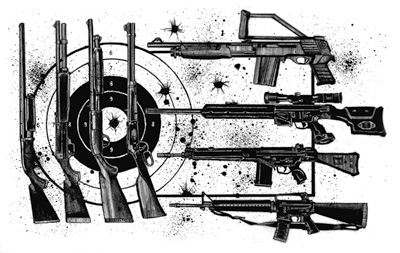
YES!!! GUNS!!!!
So after the super-dense personal firearms listings come the heavy weapons. These each require a specific Exotic Weapon Proficiency feat to use, and are generally super expensive and require military licensing. If you’re able to requisition them as mission-critical equipment, though, great! You can hose someone with a heavy machine gun for 4d12 damage (assuming you hit, at least) or spray areas or blast them with a LAW (10d6 damage that also ignores 10 points of hardness if it hits a wall or vehicle). There’s also the decently-accessible M79 grenade launcher for tactical grenading in various formats.
Rounding out the ranged weapons section are the oddities - things like the compound bow and crossbow, flamethrower (complete with easily-exploded fuel pack), javelins and shuriken, and the whip (because what would a d20 game be without whip rules?). There’s also special rules for tasers and pepper spray, which is kind of cool - the taser causes 1d6 rounds of paralysis on a failed Fortitude save after being hit (super good against all manner of softie foes) and pepper spray blinds you for 1d4 rounds if you fail your Fort save (and only requires a ranged touch attack). There’s also purchase rules for ammunition, where a dozen arrows are the most expensive ‘unit’ of projectiles (though apparently this is true-to-life).
Whew! Moving on from the minutiae of ranged weapons, the book now goes into explosives and splash weapons. These are handled in the same stat-fashion as the ranged weapons, with a couple of changes - each explosive has a burst radius along with an associated Reflex DC to save versus its effects, and splash weapons (acid vials/molotov cocktails) have a ‘direct hit damage’ value. To spare you from too much in-depth discussion of things that go boom, there are rules for C4, det cord (the coolest!), dynamite, and five different grenade types: fragmentation, smoke, tear gas, thermite, and white phosphorous (all can be used with the aforementioned M79 launcher).
d20 Modern
handles bursts and blasts in a slightly weird fashion - you choose an origin intersection on a grid, rather than an origin square, and calculate blast radius from that point. This leads to more round-looking blasts than I remember existing in 3rd-edition-land:
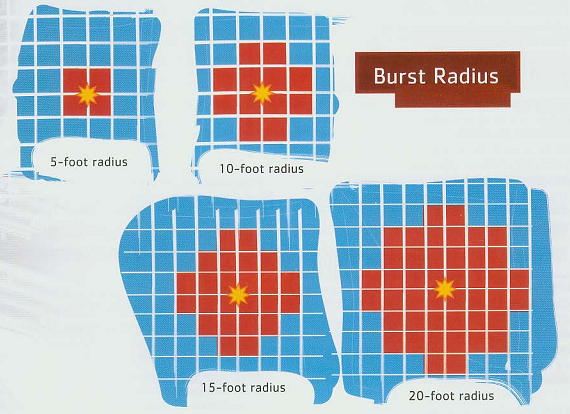
Last, but not least, we come to the melee weapons section. Since
d20 Modern
’s scope is so broad, it includes a huge pile of assorted melee weapons that allow you to play out all manner of scenario from zombie apocalypse to riot cop beatdown to Triad agents that need to cut off the hand of a rival alchemist with a rusty cleaver. They’re broken into three categories (simple, archaic, and exotic) according to feat requirements, and I’m actually going to list them because some of the options are very flavourful:
Simple weapons: brass knuckles, cleaver, club, knife, metal baton, pistol whip & rifle butt, sap, stun gun, tonfa
Archaic weapons: bayonet (fixed), hatchet, longsword, machete, rapier, spear, straight razor,
sword cane
Exotic weapons: chain, chainsaw, kama, katana, kukri, nunchaku, three-section staff
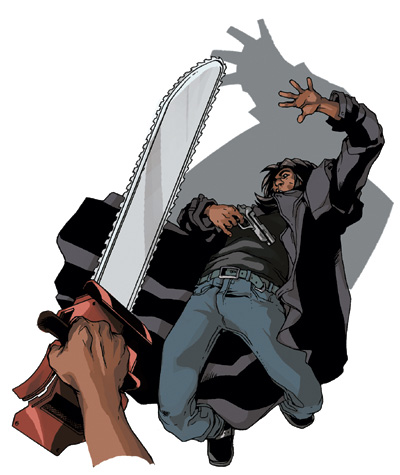
Never bring a gun to a chainsaw fight, dummy!
If you’re going to be focusing on melee weapons at all, the katana is probably your obvious winner’s choice: 2d6 damage and a 19-20 crit range make it roughly as powerful as a pistol (and there’s probably a bit better feat support) for the same feat you’d give up to take Personal Firearms Proficiency.
Last in the weapons section is a brief set of rules covering improvised weapons - they’re categorized by size (though a tire iron is considered Large while a bowling ball is only Medium) and do sad amounts of damage (the aforementioned tire iron only does 1d6, a screwdriver is a whopping 1d2) and you’re always at a -4 attack penalty when using one. Since every character is at least proficient with the club, you’re probably better off arguing with your DM that your tire iron should count as a simple weapon and going with that.
So this concludes the weapons section. Next up is armour and miscellaneous gear!
Part 8
Original SA post d20 Modern Roleplaying Game Core Rulebook - Part 8
Chapter 4 - EQUIPMENT continued!
So your death-dealing research scientist is kitted out with a shotgun and several pistols and also a katana and is totally ready to murder Batman. But it turns out that guy has, like, martial arts skills and throwing weapons and stuff! You should probably take some steps to mitigate those threats, which is where the next section of the Equipment chapter comes in.
Armour
Like the weapons, body armour in d20 Modern runs the gamut - everything from a leather jacket to plate mail is represented and statted up. Armour is broken down by weight (light/medium/heavy, each requiring a feat) and type - archaic, impromptu, concealable, and tactical - but type isstrictly a reference measure. Each armour type provides a bonus to your Defense, a lesser bonus if you’re missing the appropriate armour feat, and controls a number of quickness-related bonuses. Wearing heavier armour means getting less of a Defense bonus from your Dexterity (which is a trade-off, at least), and taking a penalty to certain skill checks and potentially your movement speed.
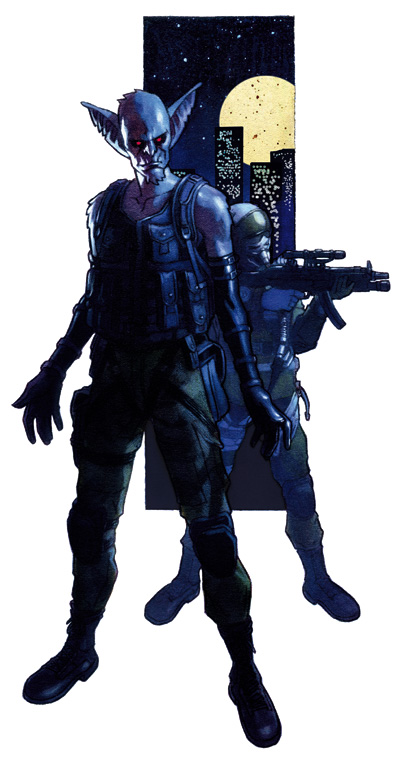
Tactical armour. Also tactical monster-person.
The armour listing includes old favourites like leather armour and the chainmail shirt, but the more modern stuff is actually pretty cool. There’s a fanny pack that pulls up into a protective vest, various formats of actual bulletproof vests for all occasions from stealth to shootouts, and full-blown tactical forced-entry armour. The armour section only runs about two pages (by comparison, weapons covers fourteen) however, and then it’s on to the next shopping list.
General Equipment
Now that you know how you’re going to kill Batman, and what you’re going to be wearing when you do it, it’s time to get down to brass tacks: you’re gonna need a whole load of gear to locate, lure, and otherwise prepare for your encounter, and also some cameras to take sweet selfies with. Luckily, this book has you covered. Where other games would fill their equipment section with a list of meals at an inn, or types of cart, d20 Modern devotes a full page to various consumer and professional goods. There’s a massive, categorized shopping list, and I’m going to go through and highlight some of the cool stuff in each section.
Bags and Boxes - gone is the simple rucksack of yore. Instead, stash your things in a briefcase, or range bag, or something called a “patrol box” which is basically just a beefy briefcase with a lock that fits on a car seat.
Clothing - there’s casual & formal options, outerwear, and a ghillie suit (which grants a whopping +10 to Hide if you’re in appropriate terrain). The game also lists a photojournalist’s vest that grants a bunch of bonuses to concealing small items on your body!
Computers and Consumer Electronics - this is sort of a neat snapshot of the times - film cameras, “PDAs”, and broadband modems listed alongside police scanners and walkie talkies.
Surveillance Gear - lots of cool stuff here including wiretapping equipment, night vision goggles, and black boxes for phone phreaking!
Professional Equipment - mostly just kits for things like forgery, demolitions, and lockpicking, but also has spike strips, fake IDs, and instruments (so you can stat out your favourite band!)
Survival Gear - chemical light sticks (awesome), electro-optical binoculars ( awesome ), and combat webbing to carry around your white phosphorous grenades.
Weapon Accessories - detonators for explosives, laser sights, and suppressors. Also, the game makes you buy your own ammunition receptacles (speed loaders/box magazines) because it’s important to account for every last pinch of salt.
So yeah, tons of stuff, but a lot of it is useful in strange plans and clever heists (the same cannot be said of the typical wages of a cartwright). Of course, no extensive table of inspiring gear would be complete without telling you how much of it you could schlep around at a given time, so the Equipment section next proceeds to cover carrying capacity. It’s the usual thing - your capacity is based on your Strength score, and you have three load categories (light/medium/heavy). Under your light load (43 lbs. for Strength 12) and you’re good. Over that, you’re encumbered - this caps your Dexterity bonus, as well as imposing a static -3 check on most Str/Dex skills. Anything over your heavy load capacity (87+ lbs. for Strength 12) and you’re heavily encumbered, which basically doubles the encumbered penalties as well as reduces your combat and running move speeds.
After carrying capacity is the Lifestyles and Services portion of the Equipment section. Lifestyle is basically just purchase DCs for homes (there’s no mention of rent, because it’s built into your Wealth bonus already), meals, plane tickets, and hotel rooms. Services cover auto repair and bail bonds, the bribery of various low-level functionaries, and the all-important hospital care. It’s important to note that the price of medical care is dependent upon the Treat Injury ranks of the doctor - you’re within your rights to go get stitched up by a veterinarian if you need to do it on the (relatively) cheap.
The last portion of the Equipment section is dedicated to Vehicles . There are thirty-seven listed in various categories (watercraft, civilian automobiles, military, etc.) and they all have a detailed stat line incorporating the following:
- crew, passenger, and cargo capacity
- initiative and maneuver penalties
- top speed and acceleration
- Defense, hardness, hit points and size (all controlling overall durability)
- purchase DC and license restrictions
As was the case with the weapons section, the listed vehicles are meant to span categories - mid-size sedans, boats, jetskis, civilian helicopters, and whatnot, and for the most part they do a pretty good job. There are probably too many different cars (eleven listed), but the other categories cover their respective spectrums pretty admirably.
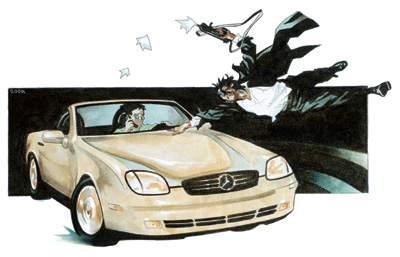
Please do not drive while using your cell phone in assault rifle territory.
And yes, as mentioned earlier by 50 Foot Ant, the M1A2 main battle tank has hardness 20. This means that any attack dealing less than 20 points of damage will not even scratch it. However, if you check back to the class section, you can, by 4th level, make a Strong hero with two ranks of the Melee Smash talent (+2 melee damage), the Power Attack and Sunder feats (trade base attack bonus for damage at 1:1, and double your damage against unattended objects), and, assuming you have 18 Strength, completely negate the hardness of every tank in the motor pool as you hack away with your katana and destroy each tank in roughly 45 seconds. Which is pretty cool for a fourth-level hero, you have to admit (this assumes, of course, your DM counts an unpiloted tank as an object).
Finally, as an additional note, I'd like to call attention to an interesting quirk of the equipment section: all the weapons and vehicles are branded. The guns are all specific real-world models ranging from the Pathfinder .22 revolver , various AK - 47s , and some kind of thing that shoots through engine blocks . Oh, and speaking of engine blocks, d20 Modern features meticulous stats for the Acura 3.2 TL, Chevy Cavalier, Ford Crown Victoria, Lamborghini Diablo, and Volkswagen Jetta, amongst a slew of other real-world vehicles. I am one hundred percent certain that they did not seek approval from the manufacturers to use these things (50 Foot Ant, prove me wrong, I'd be pleasantly shocked). Just a weird little thing in the book!
Anyhow, that’s it for the equipment section. Next up is Chapter Five: COMBAT - a guaranteed delight for all involved.